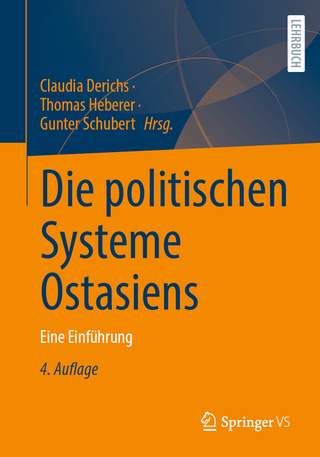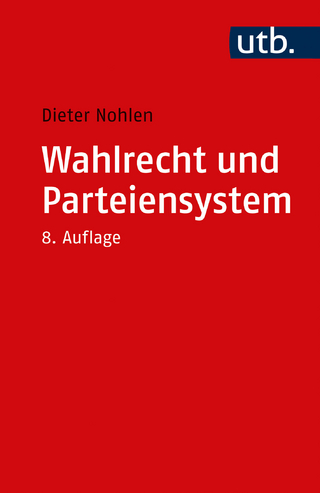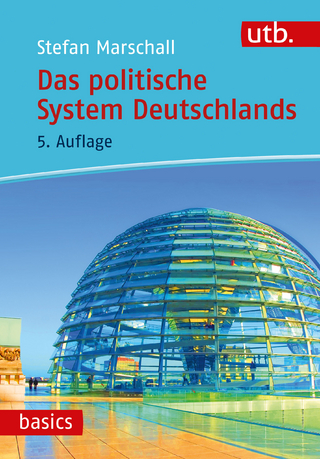
The Anatomy of Post-Communist Regimes
Central European University Press (Verlag)
978-963-386-393-0 (ISBN)
At exploring the structural foundations of post-communist regime development, the work discusses the types of state, with an emphasis on informality and patronalism; the variety of actors in the political, economic, and communal spheres; the ways autocrats neutralize media, elections, etc. The analysis embraces the color revolutions of civil resistance (as in Georgia and in Ukraine) and the defensive mechanisms of democracy and autocracy; the evolution of corruption and the workings of “relational economy”; an analysis of China as “market-exploiting dictatorship”; the sociology of “clientage society”; and the instrumental use of ideology, with an emphasis on populism. Beyond a cataloguing of phenomena—actors, institutions, and dynamics of post-communist democracies, autocracies, and dictatorships—Magyar and Madlovics also conceptualize everything as building blocks to a larger, coherent structure: a new language for post-communist regimes.
While being the most definitive book on the topic, the book is nevertheless written in an accessible style suitable for both beginners who wish to understand the logic of post-communism and scholars who are interested in original contributions to comparative regime theory. The book is equipped with QR codes that link to www.postcommunistregimes.com, which contains interactive, 3D supplementary material for teaching.
Bálint Magyar is Research Fellow at CEU Democracy Institute, working on the subject of patronalism in post-communist countries. He was a member of the Hungarian Parliament (1990-2010). As a Minister of Education (1996-1998; 2002-2006) he initiated and carried out reforms in public and higher education. Bálint Madlovics (*1993) is a political scientist and economist. He is a junior research fellow at the CEU Democracy Institute. He holds MA in Political Science (2018) from Central European University in Budapest, and BA in Applied Economics (2016) from Corvinus University of Budapest.
List of Tables and Figures
Acknowledgments
Reader’s Manual for QR Codes and Online Supplementary Material
Preface by Alena Ledeneva
Introduction
Trapped in the Language of Democratization
The Inadequacy of Existing Models for the Post-Communist Region
The Multi-Dimensional Analytical Framework: Spanning Conceptual Spaces
How It is Made: The Construction of a Conceptual Toolkit
How to Look at It: The Framework as a Structural Construction
How to Read It: A Textbook with Original Contributions
How It Unfolds: Outline of the Content
1. Stubborn Structures
1.1. Guide to the Chapter
1.2. Thesis A: Regime Type Depends on the Separation of Spheres of Social Action
1.3. Thesis B: The Separation of Spheres Followed Civilizational Boundaries
1.3.1. Civilizations and the Three Historical Regions
1.3.2. The Basic Structure of Unseparated Spheres in a Feudal Framework
1.4. Thesis C: Communist Dictatorships Arrested and Reversed the Separation of Spheres
1.4.1. The Basic Structure of Merged Spheres in Communist Dictatorships
1.4.2. The Effect of Communism on the Separation of Spheres in Different Regions
1.5. Thesis D: Democratization Did Not Change the Separation of Spheres
1.5.1. The Basic Structure of Unseparated Spheres in a Democratic Framework
1.5.2. Single-Pyramid and Multi-Pyramid Systems: The Determinants of Democratization in the Three Historical Regions
1.6. Beyond Hybridology: A Triangular Conceptual Space of Regimes
2. State
2.1. Guide to the Chapter
2.2. General Definitions: The Basic Concepts of the Framework
2.2.1. Regime, State, Violence, and Coercion
2.2.2. Elite, Ruling Elite, Patronalism, and Informality
2.3. The Dominant Principle of State Functioning
2.3.1. Societal Interest, Elite Interest, and Ideology Implementation
2.3.2. States in Democracies and Dictatorships: from Constitutional State to Party State and from Night-Watchman State through Welfare State to Developmental State
2.4. Conceptualization of States Running on Elite Interest
2.4.1. Interpretative Layers: What is the Nature of the Ruling Elite?
2.4.2. Interpretative Layers: What is the Action Targeting State Institutions?
2.4.3. Interpretative Layers: What is the Action Targeting Property?
2.4.4. Interpretative Layers: What is the Legal Status of Elite-Interested Action?
2.4.5. Combining Layers of Different Dimensions: Defining the Mafia State
2.4.6. Constitutional State vs. Mafia State: Normativity and Discretionality
2.5. Challenges to the Monopoly of Violence
2.5.1. State Failure, Violent Entrepreneurs, and Oligarchic Anarchy
2.5.2. The Legitimate Use of Violence: A Typology
2.5.3. Sub-Sovereign Mafia States
2.6. The Invisible Hand and the Grabbing Hand: A Comparative Framework for State Types
3. Actors
3.1. Guide to the Chapter
3.2. The Three Spheres of Social Action
3.3. Political Actors in the Three Polar Type Regimes
3.3.1. President/Prime Minister—Chief Patron—General Party Secretary
3.3.2. Cabinet—Patron’s Court—Politburo
3.3.3. Politician—Poligarch / Political Front Man—High Level Party Cadre
3.3.4. Trustee – Patron’s Hand (Smotryashchiy)—Middle/Low Level Party Cadre
3.3.5. Civil Servant—Patronal Servant—Administrative Cadre (Apparatchik)
3.3.6. State’s Secret Service—Patron’s Secret Service—Party’s Secret Service
3.3.7. Democratic Party (Politicians’ Party)—Patron’s Party (Vassals’ Party)— Centralized Party (Cadres’ Party)
3.3.8. Governing Party—Transmission-Belt Party – State Party
3.3.9. Opposition Party—Marginalized / Domesticated / Absorbed / Liquidated / Fake party
3.4. Economic Actors in the Three Polar Type Regimes
3.4.1. Entrepreneur—Oligarch—State Enterprise Leader
3.4.2. Lobbyist—Corruption Broker—Tolkach
3.4.3. Economic Front Man (Shell Company)
3.5. Communal Actors in the Three Polar Type Regimes
3.5.1. Citizen—Servant (Client)—Subject
3.5.2. NGO—GONGO—TRANSBO
3.5.3. Independent Church – Client Church – Repressed Church
3.6. A Ruling Elite of Colluding Spheres: The Adopted Political Family
3.6.1. What the Adopted Political Family Is and Is Not
3.6.2. The Anthropological Character of the Adopted Political Family
3.6.3. Disposing over Status and Wealth as Chief Patron
3.7. The Structure of Elites in the Six Ideal Type Regimes
3.7.1. Elites in the Three Polar Type Regimes
3.7.2. Elites in the Three Intermediate Regime Types
4. Politics
4.1. Guide to the Chapter
4.2. Civil Legitimacy and the Interpretation of the Common Good
4.2.1. Civil Legitimacy as the Basis of Modern States
4.2.2. Civil Legitimacy in Liberal Democracy: Constitutionalism
4.2.3. Civil Legitimacy in Patronal Autocracy: Populism
4.2.4. Civil Legitimacy in Communist Dictatorship: Marxism-Leninism
4.2.5. Weberian Legitimacy Patterns: Populism as a Call for Substantive-Rational Legitimacy
4.3. The Institutions of Public Deliberation in the Three Polar Type Regimes
4.3.1. Discussing: Media and the Spheres of Communication
4.3.2. Associating: Protests, Interest Groups, and Party Systems
4.3.3. Electing: Campaigns, Elections, and Referenda
4.3.4. Lawmaking: Policies, Laws, and Legislatures
4.3.5. Enforcing: Courts, Prosecution, and the Institutions of State Coercion
4.4. Defensive Mechanisms: Stability, Erosion, and the Strategies of Consolidating Democracies and Autocracies
4.4.1. Liberal Democracy: Separation of Branches of Power and Civil Society
4.4.2. Patronal Democracy: Separation of Networks of Power and Color Revolutions
4.4.3. Patronal Autocracy: Separation of Resources of Power and the Problem of Succession
4.4.4. Reversing Autocratic Change: The Regime-Critique Paradigm and Democratic Consolidation
5. Economy
5.1. Guide to the Chapter
5.2. Relational Economics as a Challenger of the Neoclassical Synthesis
5.3. Relation
5.3.1. General Definitions: Relation, Cooperation, Collusion
5.3.2. Collusion and Corruption: A Typology
5.3.3. Corruption Types in Comparison: General Dimensions and a Case Study for the Transformation of Corruption
5.3.4. Corruption Measurement, Criminal Ecosystem, and the Role of Corrupt Monies in Regime
Survival
5.3.5. Relation in Communist Dictatorships
5.3.6. The Culture of Relation in the Post-Communist Region: From Family Obligations to Blat and Guanxi
5.4. State Intervention
5.4.1. The General Framework
5.4.2. Regulatory Intervention: The Forms of Rent Creation
5.4.3. Budgetary Intervention: The Forms of Taxation and Spending
5.5. Ownership
5.5.1. Political Reorganization of Ownership Structure in the Post-Communist Region
5.5.2. Making a Privatization Profile: Technocratic and Non-Technocratic Motives
5.5.3. Making a Patronalization Profile: Predation and Property Rights
5.5.4. Predation and Economic Dynamics: Stalking Value, Hunting Value, and Booty Value
5.6. Comparative Economic Systems
5.6.1. Administrative Market, Competitive Market, and Relational Market
5.6.2. Mixed Market Economies: the Dynamic Balance of the Three Economic Mechanisms in Market-Exploiting Dictatorships
5.6.3. From Crony to Mafia: Types of Political Capitalism
6. Society
6.1. Guide to the Chapter
6.2. The Level of Social Structures: Networks and Societal Patronalization
6.2.1. Open and Limited-Access Orders: Eliminating the Strength of Weak Ties
6.2.2. Clientage Society: Inequality and Social Mobility in Patronal Autocracy
6.3. The Stability of Power and Mass Political Persuasion
6.4. The Level of Discourses: Ideology and the Political Market
6.4.1. The Supply Side: Ideology-Applying Actors and Regimes
6.4.2. The Demand Side: From Identity Politics to Conspiracy Theories
6.4.3. Populism Summarized: An Ideological Instrument for the Political Program of Morally Unconstrained Collective Egoism
6.5. Modalities of Informal Governance: A Summary
7. Regimes
7.1. Guide to the Chapter
7.2. The Triangular Framework: Defining the Six Ideal Type Regimes
7.2.1. Doubling of the Kornaian Ideal Types of Democracy, Autocracy, and Dictatorship
7.2.2. Eleven Dimensions in the Triangular Framework
7.3. Regime Dynamics: A Typology with Modelled Trajectories of Twelve Post- Communist Countries
7.3.1. General Definitions: Sequence, Trajectory, and Pattern Change
7.3.2. Primary Trajectories after Communism (Estonia, Romania, Kazakhstan, and China)
7.3.3. Secondary Trajectories after the Regime Change (Poland, the Czech Republic, Hungary, and Russia)
7.3.4. Regime Cycles and the Duality of Personal and Impersonal Institutional Change (Ukraine,
Macedonia, Moldova, and Georgia)
7.4. Beyond Regime Specificities: Country and Policy-Specific Features
7.4.1. Ethnic Cleavages as a Source of Pluralism and Disorder
7.4.2. Deep State and the Survival of Communist Secret Services
7.4.3. Country Size and the Global Ambitions of Former Empires
7.4.4. Geopolitical Orientation and the Coexistence of Liberal and Patronal Regimes in the European Union
7.4.5. Dependence of Capitalism and the Global Connections of Local Patronal Networks
7.4.6. Natural Resources and Other Sources of Distributable Rent
7.4.7. Policy-Specific Features: Regime-Based Analysis and the Room for Maneuver
Conclusion
The Significance of Language and the Basic Axioms to Analyze Post-Communist Regimes
Towards a Global Perspective: Dissolving our Implicit Axioms for the Post- Communist Region Technology and Climate Change: Era-Specific Features and the Prospects for the Future
Bibliography
Index
| Erscheinungsdatum | 10.05.2021 |
|---|---|
| Zusatzinfo | 50 Figures; 85 Tables, unspecified |
| Verlagsort | Budapest |
| Sprache | englisch |
| Maße | 210 x 270 mm |
| Gewicht | 1800 g |
| Themenwelt | Sozialwissenschaften ► Politik / Verwaltung ► Politische Systeme |
| Sozialwissenschaften ► Politik / Verwaltung ► Politische Theorie | |
| Sozialwissenschaften ► Politik / Verwaltung ► Vergleichende Politikwissenschaften | |
| Wirtschaft ► Volkswirtschaftslehre ► Wirtschaftspolitik | |
| ISBN-10 | 963-386-393-7 / 9633863937 |
| ISBN-13 | 978-963-386-393-0 / 9789633863930 |
| Zustand | Neuware |
| Haben Sie eine Frage zum Produkt? |
aus dem Bereich


